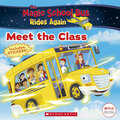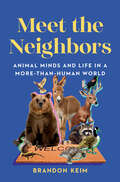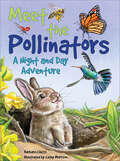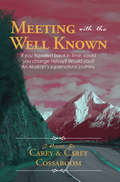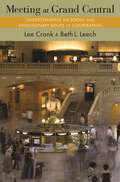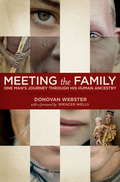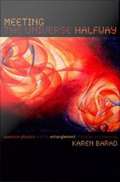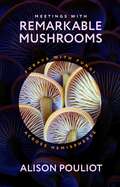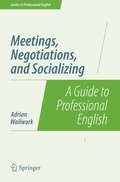- Table View
- List View
Meet the Cats (Meet The… #1)
by Kate PeridotGo on an around-the-world trip to meet eight of the world's most beloved big cats. Meet the cats that roar from the highest mountains, the hottest savannahs, and from the tallest trees in this brilliantly illustrated guide to eight species of the big cats. Explore the stunning landscapes where they live with a world map filled with big cat hotspots. Become an expert with fun feline fact files and a useful comparison chart - so you can see how the world's cats compare. Along the way, you'll even pick up tips on how to draw these clawesome carnivores!
Meet the Class (The Magic School Bus Rides Again)
by Samantha BrookeBuckle your seatbelts! The Magic School bus is ready to ride again—and kids can get to know Ms. Frizzle’s students in this colorful book.The Magic School Bus books took children on many adventurous field trips that taught them about science, inspiring an Emmy Award–winning animated show on PBS. Now Netflix has revived and updated the series for a new generation of kids.Meet Walkerville’s newest class with this introduction to The Magic School Bus perfect for young fans. Learn all about your favorite students from the original series like Keesha, Ralphie, D.A., and Arnold—plus a few new friends!
Meet the Minibeasts
by Sarah RidleyBecome a minibeast expert with this easy-to-understand guide to the wonderful and important creatures that live beside us. Have you ever wondered what the difference between a moth and a butterfly is? Or have you ever thought about how bees live together? This fascinating and comprehensive book for children aged 6+ is full of interesting facts and brilliant photographs. It also features guides to spotting your favourite minibeast in their natural habitats.Minibeasts covered: ants, aphids, bees, beetles, bugs, butterflies, centipedes, cicadas, crickets, damselflies, dragonflies, earwigs, flies, grasshoppers, harvestmen, millipedes, mites, moths, pond skaters, slugs, snails, spiders, termites, ticks, wasps, woodlice, worms.
Meet the Neighbors: Animal Minds and Life in a More-than-Human World
by Brandon KeimWhat does the science of animal intelligence mean for how we understand and live with the wild creatures around us? Honeybees deliberate democratically. Rats reflect on the past. Snakes have friends. In recent decades, our understanding of animal cognition has exploded, making it indisputably clear that the cities and landscapes around us are filled with thinking, feeling individuals besides ourselves. But the way we relate to wild animals has yet to catch up. In Meet the Neighbors, acclaimed science journalist Brandon Keim asks: what would it mean to take the minds of other animals seriously? In this wide-ranging, wonder-filled exploration of animals’ inner lives, Keim takes us into courtrooms and wildlife hospitals, under backyard decks and into deserts, to meet anew the wild creatures who populate our communities and the philosophers, rogue pest controllers, ecologists, wildlife doctors, and others who are reimagining our relationships to them. If bats trade favors and groups of swans vote to take off by honking, should we then see them as fellow persons—even members of society? When we come to understand the depths of their pleasures and pains, the richness of their family lives and their histories, what do we owe so-called pests and predators, or animals who are sick or injured? Can thinking of nonhumans as our neighbors help chart a course to a kinder, gentler planet? As Keim suggests, the answers to these questions are central to how we understand not only the rest of the living world, but ourselves. A beguiling invitation to discover an expanded sense of community and kinship beyond our own species, Meet the Neighbors opens our eyes to the world of vibrant intelligence just outside our doors.
Meet the Pollinators: A Night and Day Adventure
by Barbara CilettiThis vital and simply told story of pollination offers lush visual effects that illuminate their ongoing work by day and by night. Presented narratively, this title captivates young learners, emphasizing pollinators' vital role in our planet's survival. It conveys that even small creatures wield significant influence, illustrating pollinators' continuous journey for food. The intricate dance between pollinators and flowers is nature's wisdom in action. As flowers beckon, pollinators respond, playing a pivotal role in life's cycle. This dynamic exchange narrates the story of pollination, where pollinators fertilize plants while obtaining sustenance. Key Features: Engages young learners, emphasizing pollinators' life-giving role. Conveys that even small creatures make enormous Earth contributions. Educates about 24/7 global pollination value. Makes pollination understanding visual and accessible. Provides a closer look at pollination as a story. Includes additional teaching materials that enrich learning with pollinator bios, flower diagrams, and pollinator garden flower suggestions. This story underscores the importance of caring for Earth, highlighting its reciprocal response to positive stewardship.
Meet the Whales (Meet The… #1)
by Kate PeridotAn around-the-world trip to meet eight species of whale and learn all about them and their habitats. Includes a map of the world showing whale hotspots and a size comparison spread!
Meeting With The Well Known: If you travelled back in time, could you change history? Would you? An Alaskan's supernatural journey.
by Carey CossaboomI died in 1990, in an automobile accident in Alaska on the Seward Highway. Soon thereafter, I found myself sitting on the ground outside my home in south Anchorage. Only my home wasn't there. Actually, the whole subdivision was missing. Because I soon learned that it wasn't 1990 anymore; it was 1963. But how could that be? In 1963, I was a 9-year old boy living in upstate New York. How did I get here, and why? Could I get back the life I knew? I wanted my wife back! Meeting With The Well Known details my journey back to 1990 from 1963. The impossible circumstances, the delicate change of history, and the call of God to challenge the Church's misconception of time. An adventure so incredible, I dare not declare it as true.
Meeting at Grand Central: Understanding the Social and Evolutionary Roots of Cooperation
by Beth L. Leech Lee CronkA revolutionary approach to the study of cooperation that unites evolutionary biology and the social sciencesFrom the family to the workplace to the marketplace, every facet of our lives is shaped by cooperative interactions. Yet everywhere we look, we are confronted by proof of how difficult cooperation can be—snarled traffic, polarized politics, overexploited resources, social problems that go ignored. The benefits to oneself of a free ride on the efforts of others mean that collective goals often are not met. But compared to most other species, people actually cooperate a great deal. Why is this?Meeting at Grand Central brings together insights from evolutionary biology, political science, economics, anthropology, and other fields to explain how the interactions between our evolved selves and the institutional structures we have created make cooperation possible. The book begins with a look at the ideas of Mancur Olson and George Williams, who shifted the question of why cooperation happens from an emphasis on group benefits to individual costs. It then explores how these ideas have influenced our thinking about cooperation, coordination, and collective action. The book persuasively argues that cooperation and its failures are best explained by evolutionary and social theories working together. Selection sometimes favors cooperative tendencies, while institutions, norms, and incentives encourage and make possible actual cooperation.Meeting at Grand Central will inspire researchers from different disciplines and intellectual traditions to share ideas and advance our understanding of cooperative behavior in a world that is more complex than ever before.
Meeting the Energy Needs of Future Warriors
by Committee on Soldier Power/Energy SystemsThe central characteristic of the evolution of the combat soldier in recent years is an increasingly sophisticated array of sensing, communications, and related electronics for use in battlefield situations. The most critical factor for maintaining this evolution will be the development of power supply systems capable of operating those electronics effectively for missions up to 72 hours long. To address the challenge, it is important that new approaches be sought on how to integrate and power these electronics. To assist in addressing this problem, the Army requested the National Research Council to review the state of the art and to recommend technologies that will support the rapid development of effective power systems for the future warrior. This report presents the results of that review. It provides an assessment of various technology options for different power level requirements, power system design, and soldier energy sinks. The report also describes future design concepts, focusing on low-power systems. Recommendations for technology development and system design are presented.
Meeting the Family
by Donovan Webster Spencer WellsDonovan Webster brings his vivid journalistic gifts to a new subject, tracing our deep genealogy using cutting-edge DNA research to map our eons-old journey from prehistoric Africa into the modern world. With the same genetic haplotype as many white American males, Webster makes an ideal subject--he is a genuine Everyman. While his voice and spirit are unique to him, in exploring his own ancestry, he shows us our own.Drawing on National Geographic's Genographic Project, the largest anthropologic DNA study of its kind, Webster traces centuries of migrations, everywhere finding members of his now far-flung genetic family. In Tanzania's Rift Valley, he hunts with Julius, whose tribe speaks a click language, and wanders the ruins of ancient Mesopotamia with Mohamed and Khalid, now Jordanian citizens. In Samarkand, Uzbekistan, eastern frontier of his ancestral roaming, a circus ringmaster becomes both friend and link to his primal bloodline.Webster's genographic quest leads him to contemplate what traits he shares with those he meets, and considers what they and their ways of life reveal about the deep history of our species. A lifetime of journalistic travels among a wide range of cultures furnish Webster with a wealth of colorful threads to weave into a story as particularly personal as it is universally human.
Meeting the Family: One Man's Journey Through His Human Ancestry
by Donovan WebsterDonovan Webster brings his vivid journalistic gifts to a new subject, tracing our deep genealogy using cutting-edge DNA research to map our eons-old journey from prehistoric Africa into the modern world. With the same genetic haplotype as many white American males, Webster makes an ideal subject-he is a genuine Everyman. While his voice and spirit are unique to him, in exploring his own ancestry, he shows us our own. Drawing on National Geographic's Genographic Project, the largest anthropologic DNA study of its kind, Webster traces centuries of migrations, everywhere finding members of his now far-flung genetic family. In Tanzania's Rift Valley, he hunts with Julius, whose tribe speaks a click language, and wanders the ruins of ancient Mesopotamia with Mohamed and Khalid, now Jordanian citizens. In Samarkand, Uzbekistan, eastern frontier of his ancestral roaming, a circus ringmaster becomes both friend and link to his primal bloodline. Webster's genographic quest leads him to contemplate what traits he shares with those he meets, and considers what they and their ways of life reveal about the deep history of our species. A lifetime of journalistic travels among a wide range of cultures furnish Webster with a wealth of colorful threads to weave into a story as particularly personal as it is universally human.
Meeting the Universe Halfway: Quantum Physics and the Entanglement of Matter and Meaning
by Karen BaradMeeting the Universe Halfway is an ambitious book with far-reaching implications for numerous fields in the natural sciences, social sciences, and humanities. In this volume, Karen Barad, theoretical physicist and feminist theorist, elaborates her theory of agential realism. Offering an account of the world as a whole rather than as composed of separate natural and social realms, agential realism is at once a new epistemology, ontology, and ethics. The starting point for Barad's analysis is the philosophical framework of quantum physicist Niels Bohr. Barad extends and partially revises Bohr's philosophical views in light of current scholarship in physics, science studies, and the philosophy of science as well as feminist, poststructuralist, and other critical social theories. In the process, she significantly reworks understandings of space, time, matter, causality, agency, subjectivity, and objectivity. In an agential realist account, the world is made of entanglements of "social" and "natural" agencies, where the distinction between the two emerges out of specific intra-actions. Intra-activity is an inexhaustible dynamism that configures and reconfigures relations of space-time-matter. In explaining intra-activity, Barad reveals questions about how nature and culture interact and change over time to be fundamentally misguided. And she reframes understanding of the nature of scientific and political practices and their "interrelationship. " Thus she pays particular attention to the responsible practice of science, and she emphasizes changes in the understanding of political practices, critically reworking Judith Butler's influential theory of performativity. Finally, Barad uses agential realism to produce a new interpretation of quantum physics, demonstrating that agential realism is more than a means of reflecting on science; it can be used to actually do science.
Meeting the Universe Halfway: Quantum Physics and the Entanglement of Matter and Meaning
by Karen BaradThis is an ambitious book with far-reaching implications for numerous fields in the natural sciences, social sciences, and humanities. In this volume, Karen Barad, theoretical physicist and feminist theorist, elaborates her theory of agential realism. Offering an account of the world as a whole rather than as composed of separate natural and social realms, agential realism is at once a new epistemology, ontology, and ethics. The starting point for Barad's analysis is the philosophical framework of quantum physicist Niels Bohr. Barad extends and partially revises Bohr's philosophical views in light of current scholarship in physics, science studies, and the philosophy of science as well as feminist, poststructuralist, and other critical social theories. In the process, she significantly reworks understandings of space, time, matter, causality, agency, subjectivity, and objectivity. In an agential realist account, the world is made of entanglements of "social" and "natural" agencies, where the distinction between the two emerges out of specific intra-actions. Intra-activity is an inexhaustible dynamism that configures and reconfigures relations of space-time-matter. In explaining intra-activity, Barad reveals questions about how nature and culture interact and change over time to be fundamentally misguided. And she reframes understanding of the nature of scientific and political practices and their "interrelationship." Thus she pays particular attention to the responsible practice of science, and she emphasizes changes in the understanding of political practices, critically reworking Judith Butler's influential theory of performativity. Finally, Barad uses agential realism to produce a new interpretation of quantum physics, demonstrating that agential realism is more than a means of reflecting on science; it can be used to actually do science.
Meetings with Remarkable Mushrooms: Forays with Fungi across Hemispheres
by Alison PouliotA whirlwind journey through fungus frontiers that underscores how appreciating fungi is key to understanding our planet’s power and fragility. What can we learn from the lives of fungi? Splitting time between the northern and southern hemispheres, ecologist Alison Pouliot ensures that she experiences two autumns per year in the pursuit of fungi—from Australia’s deserts to Iceland’s glaciers to America’s Cascade Mountains. In Meetings with Remarkable Mushrooms, we journey alongside Pouliot, magnifiers in hand, as she travels the world. With Pouliot as our guide, we smell fire-loving truffles that transform their scent after burning to lure mammals who eat them and, ultimately, spread their spores. We spot the eerie glow of the ghost fungus, a deceptive entity that looks like an edible oyster mushroom but will soon heave back out—along with everything else in your stomach—if you take a bite. And we crawl alongside vegetable caterpillars, which are neither vegetable nor caterpillar but a fungus that devours insects from the inside out. Featuring stunning color photographs of these mycological miracles, Meetings with Remarkable Mushrooms shows that understanding fungi is fundamental for harmonizing with the natural world.
Meetings with Remarkable Mushrooms: Forays with Fungi across Hemispheres
by Alison PouliotA whirlwind journey through fungus frontiers that underscores how appreciating fungi is key to understanding our planet’s power and fragility.What can we learn from the lives of fungi? Splitting time between the northern and southern hemispheres, ecologist Alison Pouliot ensures that she experiences two autumns per year in the pursuit of fungi—from Australia’s deserts to Iceland’s glaciers to America’s Cascade Mountains. In Meetings with Remarkable Mushrooms, we journey alongside Pouliot, magnifiers in hand, as she travels the world.With Pouliot as our guide, we smell fire-loving truffles that transform their scent after burning to lure mammals who eat them and, ultimately, spread their spores. We spot the eerie glow of the ghost fungus, a deceptive entity that looks like an edible oyster mushroom but will soon heave back out—along with everything else in your stomach—if you take a bite. And we crawl alongside vegetable caterpillars, which are neither vegetable nor caterpillar but a fungus that devours insects from the inside out.Featuring stunning color photographs of these mycological miracles, Meetings with Remarkable Mushrooms shows that understanding fungi is fundamental for harmonizing with the natural world.
Meetings, Negotiations, and Socializing: A Guide to Professional English (Guides to Professional English)
by Adrian WallworkThis book is a guide to taking part in meetings and negotiations, and to the socializing required before and after such events. If you are a non-native English speaker, with an intermediate level and above, and you work for a company with international relations, then this book is the solution to all your English problems!Four main topics are covered:1. Meetings2. Negotiations3. Socializing4. How to understand fast-speaking native English speakersThis book is designed to be used like a manual or user guide - you don't need to read it starting from page 1. Like a manual it has lots of short subsections, and is divided into short paragraphs with many bullet points. This is to help you find what you want quickly and also to assimilate the information as rapidly and as effectively as possible. The book concludes with a chapter of useful phrases.There is an introduction for trainers on how to teach the skills required for meetings, negotiations and socializing in Business / Commercial English.
Mega-Predators of the Past
by Melissa StewartAward-winning nonfiction author and science specialist Melissa Stewart offers young readers a mega-exploration of little-known prehistoric predators that rival even the mightiest of dinosaurs!It is time for T. rex and his dinosaur cousins to step aside and let other mega-predators like the terror bird and the giant ripper lizard take the spotlight! Travel back to prehistoric times and meet some of the most impressive creatures to ever roam the Earth. You'll be amazed at the size and the fierceness of these lesser-known predators, many of them ancient ancestors of animals that we still see today. Stewart's cheeky, humorous voice—along with a comical version of the familiar "comparison man"—put these creatures in perspective. Artist and former zoologist Howard Gray brings these predators (back) to life with dynamic, humorous, and scientifically accurate illustrations. Sidebars and extensive back matter material provide more detailed information and context.
Mega-Predators of the Past
by Melissa StewartMeet our amazing mega-predators of the past, from the great T. rex to the lesser-known but equally oversized and ferocious predators, such as the griffenfly, the giant ripper lizard, and the terror bird!Go on a mega-exploration of prehistoric predators that rival even the mightiest of dinosaurs! Travel back to prehistoric times and meet some of the most impressive creatures to ever roam the Earth.With lively artwork from national history illustrator Howard Gray, this is a fascinating account of some of the most amazing creatures ever to inhabit Earth."A creature feature presented, and likely to be devoured, with relish." -Kirkus Reviews"The handsome, lifelike illustrations are chock full of action andexpression." -Booklist
Megacatastrophes!: Nine Strange Ways the World Could End
by David Darling Dirk Schulze-MakuchCelebrate the year of the Mayan Apocalypse in style with Megacatastrophes!, as Dr. David Darling and Dr. Dirk Schulze-Makuch delve into the amazing science of the end of the world.Could it be the asteroid hurtling towards us from outer space, or a super-volcano covering the Earth under a cloud of ash; black holes gobbling up the solar system, or a tiny army of nanobots in a deranged feeding frenzy? Oh, and don't forget -- there's always the risk of alien invasion. Rating the likelihood of each potential disaster, David and Dirk provide the best guide to the worst that could happen, and explore what we could do to save our souls. So sit down, face the inevitable, and prepare to discover the nine weirdest ways we could all go to meet our maker.
Megacities: Our Global Urban Future
by Frauke Kraas Martin Coy Surinder Aggarwal Günter MertinsAs urbanization continues, and even accelerates, scientists estimate that by 2015 the world will have up to 60 'megacities' - urban areas with more than five million inhabitants. With the irresistible economic attractions of urban centers, particularly in developing countries, making the influx of citizens unstoppable, many of humankind's coming social, economic and political dramas will be played out in megacities. This book shows how geographers and Earth scientists are contributing to a better understanding of megacities. The contributors analyze the impact of socio-economic and political activities on environmental change and vice versa, and identify solutions to the worst problems. They propose ways of improving the management of megacities and achieving a greater degree of sustainability in their development. The goals, of wise use of human and natural resources, risk reduction (both social and environmental) and quality of life enhancement, are agreed upon. But, as this text proves, the means of achieving these ends are varied. Hence, chapters cover an array of topics, from health management in Indian megacities, to planning in New York, to transport solutions for the chronically traffic-choked Bangkok. Authors cover the impact of climate change on megacities, as well as less tangible issues such as socio-political fragmentation in the urban areas of Rio de Janeiro. This exploration of some of the most crucial issues that we face as a species sets out research that is of the utmost importance, with the potential to contribute substantially to global justice and peace - and thereby prosperity.
Megafauna: Giant Beasts of Pleistocene South America (Life of the Past)
by Sergio F. Vizcaíno Richard A. Fariña Gerry De Iuliis“An enjoyable read that provides a substantial amount of detail on the biology, ecology, and distribution of these fantastic animals . . . Highly recommended.” —ChoiceMore than 10,000 years ago spectacularly large mammals roamed the pampas and jungles of South America. This book tells the story of these great beasts during and just after the Pleistocene, the geological epoch marked by the great ice ages. Megafauna describes the history and way of life of these animals, their comings and goings, and what befell them at the beginning of the modern era and the arrival of humans. It places these giants within the context of the other mammals then alive, describing their paleobiology—how they walked; how much they weighed; their diets, behavior, biomechanics; and the interactions among them and with their environment. It also tells the stories of the scientists who contributed to our discovery and knowledge of these transcendent creatures and the environment they inhabited. The episode known as the Great American Biotic Interchange, perhaps the most important of all natural history “experiments,” is also an important theme of the book, tracing the biotic events of both North and South America that led to the fauna and the ecosystems discussed in this book.“Collectively, this book brings attention to the discovery and natural history of ancient beasts in South America while providing a broader temporal and geographic background that allows readers to understand their evolution and potential immigration to South America.” —Quarterly Review of Biology“An excellent volume . . . This book is likely to facilitate progress in the understanding of fossil mammals from the Americas.” —Priscum
Megaliths, Myths and Men: An Introduction to Astro-Archaeology
by Peter Lancaster BrownAs commonly used, the term "megaliths" refers to huge, free-standing, neolithic stones whose origin and meaning have long been debated by archaeologists and students of prehistory. Perhaps the most famous neolithic site is Stonehenge, the great circle of giant stones on Salisbury Plain in England. Twentieth-century studies of Stonehenge and other megalithic monuments have given rise to the science of astra-archaeology, i.e, the study of early astronomical knowledge through the interpretation of ancient monuments and other archaeological data.The present volume, by a noted British astronomer, provides a unique introduction to this fascinating discipline. The heart of the book is devoted to a detailed study of Stonehenge (six chapters alone), along with scores of equally mysterious megalithic rings and earthworks scattered throughout the British Isles and northwestern France. Enhanced with more than 140 photos, maps, and illustrations, the text examines Stone Age sculpture, astronomical computations, radiocarbon elating, Egyptian pyramidology, Druidic and other folklore, and many other aspects of the topic.Impartial, painstakingly researched, and lucidly written, the text is an "essential summary of astronomy in the Stone Age" (New Scientist) and a "fascinating, up-to-date sourcebook for the layperson and specialist." (Publishers Weekly). Prologue. Introduction. Notes. References. Bibliography. Index. 142 black-and-white illustrations.
Megatrends Defining the Future of Tourism: A Journey Within the Journey in 12 Universal Truths (Anticipation Science #6)
by Valentina Boschetto DoorlyThis book identifies and describes five megatrends that will define the landscape of the Travel, Tourism & Hospitality industry, with a particular focus on the European context. Humans began travelling on the same day that Homo Sapiens first realized he could walk upright. No boundaries, mountains or cliffs have managed to stop or diminish our insatiable desire to find out what lies beyond the visible horizon. Tourism has enjoyed virtually uninterrupted growth for the past several decades, and the sector has now become the third-largest source of export revenue, after chemicals and fuel, and ahead of the automotive and food sectors. And yet, in its current globalised format, it is exposed to sudden shocks that can swiftly shake up the status quo accelerating the deployment of some megatrends here described. We have all witnessed the Covid-19 pandemic and its devastating consequences for the industry. While the number of international tourism arrivals to Europe has soared to over 700 million a year, at the same time we are experiencing a period of deep transformation. Bauman couldn’t have been more accurate or insightful when he coined the word ‘liquid’ in this regard. As an exquisite expression of a civilized, rich and discerning first-world society, travel and tourism are now changing shape and meaning, requiring our business models to adapt. What are the megatrends that will dictate the future shape of our industry’s landscape? Who is the new tourist, if there is one, and what is she looking for? Is the new post-technological era transforming the depth and the very essence of travelling? This book offers a number of visionary insights, as well as operational takeaways.
Mehr als Sonne, Wind und Wasser: Energie für eine neue Ära (Erlebnis Wissenschaft)
by Christian SynwoldtWhat are the energy sources of the future and what technologies can we rely on? These are the questions that show the precarious situation our planet is in. Which is why we need solid answers - for laypeople and the scientifically-minded as well as for politicians and students of the relevant disciplines. The author provides here a compact and comprehensible overview of our future energy resources. Alongside a detailed and richly illustrated introduction to the various technologies, he also discusses the fundamental problem of energy storage. The author is an electrical engineer working as a consultant for a group of inventors in regenerative energies, and reports on the latest research approaches.
Mehr als die Summe der Teile: Komplexität in der Natur
by Helmut SatzVon der Physik bis zur Informationstheorie und Kosmologie, von der Struktur tierischer Gesellschaften bis zur linguistischen Analyse der menschlichen Schrift zeigen Systeme, die aus vielen interagierenden Bestandteilen bestehen, oft ein kollektives Verhalten, das sich nicht aus der Interaktion der einzelnen Bestandteile vorhersagen lässt. In Mehr als die Summe der Teile befasst sich Helmut Satz mit verschiedenen Formen dieses komplexen Verhaltens, die erst in den letzten Jahrzehnten gründlich untersucht worden sind. Obwohl diese Studien ihren Ursprung in der Physik haben, erweist sich das Verhalten als universell und reicht von der Struktur des frühen Universums über die Bildung von Vogelschwärmen bis hin zur Häufigkeit von Wörtern in literarischen Texten. Die Komplexität wird somit zu einem immer wichtigeren interdisziplinären Bereich für die künftige wissenschaftliche Forschung.Auf konzeptionelle und nicht-technische Weise erschließt Satz dieses spannende Gebiet für eine allgemeine Leserschaft und für Studierende aller naturwissenschaftlichen Fächer.

